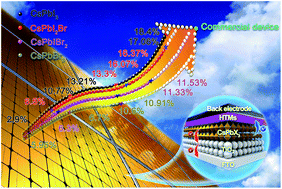Inorganic perovskite solar cells: an emerging member of the photovoltaic community
Abstract
Perovskite solar cells (PSCs) have attracted tremendous interest because of their rapid improvement in power conversion efficiency (PCE) from the initial PCE of 3.8% for the first prototype to the certified PCE of 25.2% in 2019. However, the inherent chemical instability of organic–inorganic hybrid perovskite halides influenced by moisture, heat and ultraviolet light is still a critical issue for them to meet application-specific requirements owing to the weak-bonded organic components in the hybrid crystal structure. The use of all-inorganic perovskites CsPbI3−xBrx (x = 0, 1, 2, and 3) as light-harvesters by completely substituting organic species with inorganic Cs+ ions has been recently regarded as a promising solar conversion technology. Since the initial efficiency of 2.9% achieved in 2015, the highest PCE record for inorganic PSCs has risen to 18.4% through structure optimization, compositional engineering, interfacial engineering, solvent control and surface passivation, etc. This article is dedicated to providing an up-to-date review on the development of inorganic PSCs tailored by various inorganic perovskite materials with gradually changed optical properties and stability, as well as the film-making methods and interfacial engineering technologies. Their limited efficiencies in theory and recombination mechanisms are also predicted with a detailed balance model. Finally, we focused on the state-of-the-art strategies for enhancing the photovoltaic performance and identified new challenges and outlooks for future studies in this field.

- This article is part of the themed collection: Recent Review Articles


 Please wait while we load your content...
Please wait while we load your content...